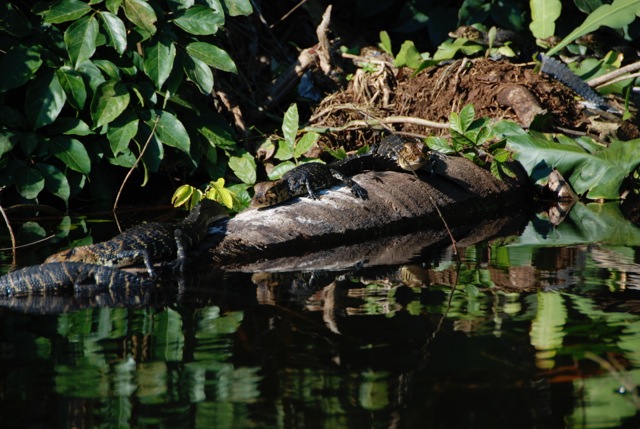Black caiman along the River Beni, Amazon Basin, Bolivia
young reader of OOTH (Cash) asked about Nile crocodiles – but since I have never seen one of these we had to settle for this large critter. This species is found throughout the Amazon Basin but its range does extend further north. The species occurs in Bolivia, Brazil, Columbia, Ecuador, Guyana, Peru, Venezuela and French Guiana. It is typically found in slow moving freshwater areas such as streams, lakes, wetlands and the flooded savannah during the rainy season.
They are very dark with banding on their lower jaw, which is particularly prominent when they are young.These are among the largest existing reptiles and the largest of the family Alligatoridae. Adult black caimans age generally 9-14 ft long with older ones growing up to 16 feet long and weighing up to 880 lbs. They prey on a variety of fish, birds, reptiles, and mammals – so not very picky. Larger prey such as deer, peccaries, tapirs and capybaras will be taken as they approach the river.
Hatchlings will eat smaller items such as fish, frogs and invertebrates. As with other crocodilian species their teeth are best for grasping but not chewing, so they will try to swallow prey whole after drowning it. If it is too large to swallow it may be stored underwater beneath a root wad or log until it rots and is easier to tear apart. Reminds me of a couple college roommates and their refrigerator habits. The only real threat to the black caiman, besides man, is the jaguar. Here’s a short loop: https://www.youtube.com/watch?v=FPE6TTiUfmU&list=PLGl69RQOsaPyTrKcdLe1TURr4vSZ2iB1f
Towards the end of the dry season the females build a nest of mounded soil and vegetation about 5 feet across and lays up to 65 eggs, which will hatch in about six weeks. This is timed for the beginning of the wet season that allows the youngsters to inhabit shallow flooded areas. The females will listen for the young hatching out (as they squeak) and dig them up and carry them to nursery pools. When this behavior was first observed in the species group it was thought that the adults were eating their young, or young of other adults. But they are quite caring and protective of the youngsters as they gain size in nursery pools.

he genus Melanosuchus means “black crocodile “and the species name of niger comes from the Latin black. So I guess this translates to a black-black caiman. Caiman were heavily hunted for its tough skin beginning in earnest during the 1940s and extended into the 19702 and beyond. During the 1970’s Columbia alone exported 66,000 caiman hides annually. Because of this insistent hunting the population declined by 99% over the last century.
Illegal hunting continues, and combined with continued deforestation and burning of swamplands has kept the number of caimans low. In Brazil and Bolivia the reduction of the caiman population has had a corresponding effect as indicated by an increase in some prey populations such as capybara (world’s largest rodent) leading to a rise in crop damage. There have been some indications that another caiman prey item – the piranha – is on the rise and has caused an increase on cattle attacks in flooded fields. A real ankle-biter!
It’s also thought that throughout much of its range the general size of the species has been reduced through this extensive history of hunting. These photos are from the River Beni in the Bolivian Amazon. After we were out birding all morning and came back to the camp once it started getting warm it was time to cool off. I was hot and buggy and the guide suggested just jumping into the adjacent oxbow lake. I asked about the caiman and piranha in the lake and his response was a bit casual – “Oh, they won’t bother you”.
Well, I took his word for it and cooled off. I did glance around the shoreline first, however.
